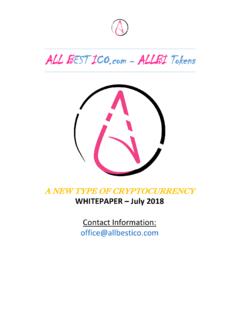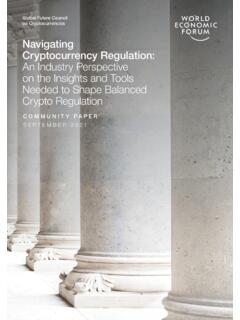Transcription of Blockchain: Opportunities for Health Care
1 Blockchain: Opportunities for Health Care by RJ Krawiec, Dan Housman, Mark White, Mariya Filipova, Florian Quarre, Dan Barr, Allen Nesbitt, Kate Fedosova, Jason Killmeyer, Adam Israel, Lindsay Tsai2 This white paper was developed in response to the Department of Health and Human Services Office of the National Coordinator for Health Information Technology (ONC) ideation challenge The Use of Blockchain in Health IT and Health -Related Research. It was selected as one of the winning papers from a field of over 70 submissions from a wide range of individuals, organizations, and companies addressing ways in which blockchain technology might be used in | August 20161[Blockchain] does offer a promising new distributed framework to amplify and support integration of Health care information across a range of uses and A new model for Health Information ExchangesHIE pain pointsBlockchain Opportunities Establishing a trust network depends on the HIE as an intermediary to establish point-to-point sharing and book-keeping of what data was exchanged.
2 Disintermediation of trust likely would not require an HIE operator because all participants would have access to the distributed ledger to maintain a secure exchange without complex brokered per transaction, given low transaction volumes, reduces the business case for central systems or new edge networks for participating groups. Reduced transaction costs due to disintermediation, as well as near-real time processing, would make the system more efficient. Master Patient Index (MPI) challenges arise from the need to synchronize multiple patient identifiers between systems while securing patient privacy. Distributed framework for patient digital identities, which uses private and public identifiers secured through cryptography, creates a singular, more secure method of protecting patient identity.
3 Varying data standards reduce interoperability because records are not compatible between systems. Shared data enables near real-time updates across the network to all parties. Limited access to population Health data , as HIE is one of the few sources of integrated , secure access to patient longitudinal Health data across the distributed ledger. Inconsistent rules and permissions inhibit the right Health organization from accessing the right patient data at the right time. Smart contracts create a consistent, rule-based method for accessing patient data that can be permissioned to selected Health organizations. A blockchain powered Health information exchange could unlock the true value of interoperability. Blockchain-based systems have the potential to reduce or eliminate the friction and costs of current intermediaries.
4 Particularly compelling use cases for blockchain technology include the Precision Medicine Initiative, Patient Care and Outcomes Research (PCOR), and the Nationwide Interoperability Roadmap. For these and other high-potential areas, determining the viability of the business case for blockchain is paramount to realize the benefits of improved data integrity, decentralization and disintermediation of trust, and reduced transaction exchange of personal Health Records and Health Information Exchange (HIE) data via the Integrating the Health care Enterprise (IHE) protocol is an important part of addressing the challenges of system interoperability and accessibility of medical records. The strategy outlined to date provides the technical requirements and specific incentives for Health systems to meet the Meaningful Use interoperability standards necessary to support the envisioned National Health Information Network, buttressed by a network of HIEs operating on a broad scale.
5 That unrealized scale, driven in large part by insufficient incentives outside of compliance, threatens the viability of HIEs and merits exploration of new models. It may be possible that new value based models embedded in MACRA will be sufficient to make the market model work, but HIEs have been seeking alternative business models. Meanwhile the Health systems that see true benefits from establishing a clinically integrated network in order to engage in risk-based contracts focus on private exchanges and are looking for low cost solutions that enable secure integration and support the assembly of virtual Health systems that move beyond organizational boundaries. While blockchain technology is not a panacea for data standardization or system integration challenges, it does offer a promising new distributed framework to amplify and support integration of Health care information across a range of uses and stakeholders.
6 It addresses several existing pain points and enables a system that is more efficient, disintermediated, and secure. 2 What is Blockchain?At its core, blockchain is a distributed system for recording and storing transaction records. More specifically, blockchain is a shared, immutable record of peer-to-peer transactions built from linked transaction blocks and stored in a digital ledger. Blockchain relies on established cryptographic techniques to allow each participant in a network to interact ( store, exchange, and view information), without preexisting trust between the parties. In a blockchain system, there is no central authority; instead, transaction records are stored and distributed across all network participants. Interactions with the blockchain become known to all participants and require verification by the network before information is added, enabling trustless collaboration between network participants while recording an immutable audit trail of all interactions.
7 Deloitte s blockchain framework1 serves as a simple guide for organizations interested in utilizing blockchain technology. It can help guide decision making by answering four key questions: When should organizations initiate blockchain pilots? How should they design the use cases? When should they strengthen the system through smart contracts? Should they implement permissioned, permissionless, or consortium blockchains? For organizations new to the technology, the guided, four-step process simplifies a complex, rapidly evolving field into a series of discrete decisions. Before leaders initiate blockchain projects, they should consider whether the technology is suitable to the organization s needs. Not all problems require a blockchain solution. Blockchain truly shines when four conditions have been met: (1) multiple parties generate transactions that change information in a shared repository, (2) parties need to trust that the transactions are valid2, (3) intermediaries are inefficient or not trusted as arbiters of truth, and (4) enhanced security is needed to ensure integrity of the system.
8 For Health care organizations that have decided to initiate blockchain projects, the next step is to design the use cases. There are two primary use cases to consider: (1) verify and authenticate information, or (2) transfer framework 1. Do pre-conditions for using blockchain technology exist? 2. Which applications are relevant for us?3. Do we need to enforce contracts automatically?4. What blockchain will we use to implement our solution? Permissionless blockchain for interoperability, open innovation, enhanced security, and access to greater, distributed computing power to verify transactions through proof-of-work. Public blockchains currently handle fewer transactions per or consortium blockchain for restricted access, authorized innovation, and greater number of transactions per second, which are verified through proof-of-stake.
9 Multiple parties generate transactions that change information in a shared repositoryIncrease trust through smart contractsParties rely on contracts that are automatically enforced when pre-determined conditions are need to trust that transactions are valid Intermediaries are inefficient or not trusted as arbiters of truthTransfer valueParties buy, sell, and transfer value without an intermediary ( , medical claims data , cryptocurrency payments, intellectual proper t y, etc.) Enhanced security is needed to ensure integrity of the systemIf these conditions are not met, or are only partially met, a standard database or other solution may be more suitable. Transfer and authenticate information Parties use the distributed ledger to validate whether data is valid.(Note: this requires some trust that data is accurately stored).
10 InitiateDesignStrengthenImplementFigure 1: Deloitte Blockchain Decision Framework 2 Blockchain | August 20163 Deloitte s blockchain framework1 serves as a simple guide for organizations interested in utilizing blockchain technology. In the first use, organizations may consider blockchain technology to verify a patient s digital identity, genetics data , or prescriptions history. Prescrypt, a proof-of-concept developed by Deloitte Netherlands, in collaboration with SNS Bank and Radboud3, gives patients complete ownership of their medical records, allowing them to grant and revoke provider access to their data . Providers, in turn, can issue prescriptions on the blockchain. In the second application, organizations can use the technology to transfer value, such as cryptocurrencies or intellectual property rights.














